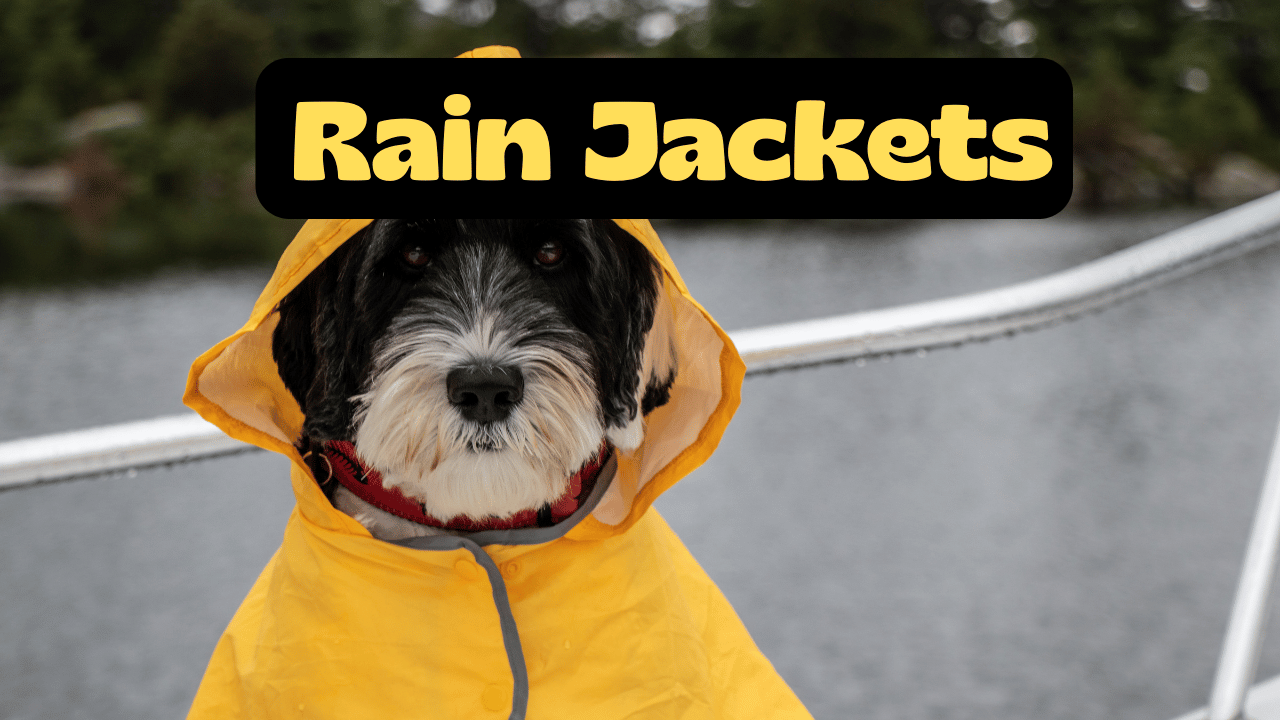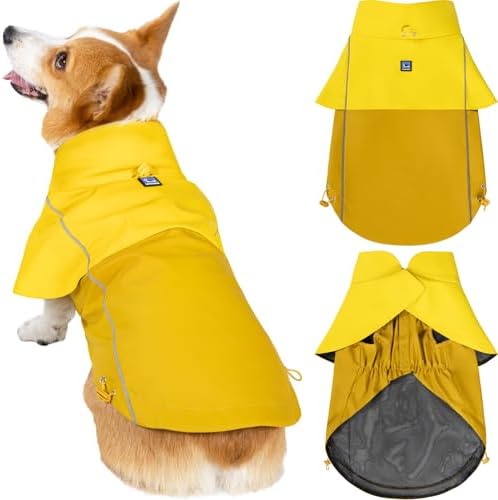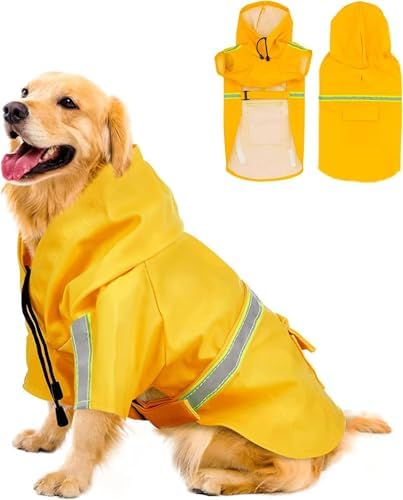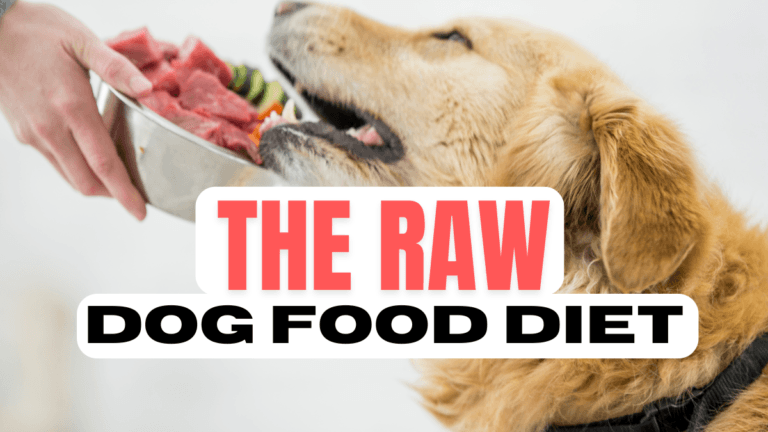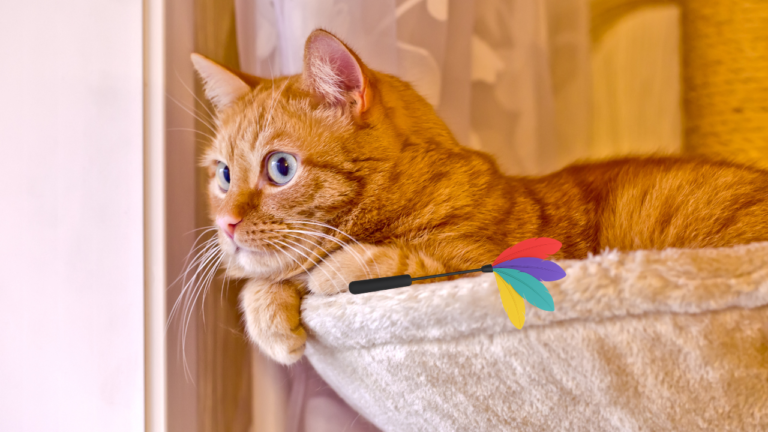The 7 Best Dog Rain Jackets That Actually Keep Your Pup Dry in 2026
Disclosure: This post contains affiliate links. If you click through and make a purchase, I may earn a small commission at no extra cost to you. I only recommend products I believe will genuinely benefit you and your pets. Dog Rain Jackets You know that moment when you open…
Disclosure: This post contains affiliate links. If you click through and make a purchase, I may earn a small commission at no extra cost to you. I only recommend products I believe will genuinely benefit you and your pets.
Dog Rain Jackets
You know that moment when you open the door for your morning walk and it’s pouring rain? Your dog looks at you. You look at your dog. You both know what’s about to happen—and neither of you is thrilled about it.
Twenty minutes later, you’re back home with a soaking wet dog who smells like a swamp creature. Water is dripping everywhere. Your clean floors are now muddy. Your dog is shaking vigorously, spraying water across your furniture. And you’re standing there with a towel, wondering why you even bothered with that walk.
There’s a better way.
A good dog rain jacket isn’t just about keeping your dog dry—though that’s obviously the main point. It’s about making rainy day walks tolerable for both of you. It’s about reducing cleanup time. It’s about your dog actually being comfortable outside instead of miserable and shivering.
But here’s the thing: not all dog rain jackets work. Some leak. Some don’t fit. Some are so difficult to put on that your dog runs away the second they see you holding it. And some cost way too much for what they actually deliver.
I’m going to walk you through everything you need to know about dog rain jackets—which dogs actually need them, what features matter, how to size correctly, and which brands are worth your money.
Does Your Dog Actually Need a Rain Jacket?
Let’s be honest. Not every dog needs a rain jacket.
A healthy adult Labrador Retriever with a thick double coat? Probably fine without one. Huskies, Newfoundlands, Saint Bernards—breeds developed to work in harsh weather with naturally water-resistant coats—they’re generally good to go.
But a lot of dogs benefit significantly from rain protection.
Short-haired breeds like Greyhounds, Whippets, Pit Bulls, and Boxers don’t have the coat density to stay warm when wet. Small dogs like Chihuahuas, Yorkies, and Toy Poodles lose body heat quickly and can get dangerously cold in wet weather. Senior dogs with arthritis feel the cold and damp more acutely. Puppies haven’t developed full coat protection yet.
Dogs with thin coats or single coats—like many terriers, some spaniels, and mixed breeds—get soaked through to the skin almost immediately in rain. And once a dog is wet and cold, the walk stops being enriching exercise and starts being miserable endurance.
Even breeds with decent coats appreciate staying dry. Yes, my friend’s Labradors technically don’t need rain jackets. But she started using them anyway because it cuts her post-walk cleanup time in half. No more toweling off wet dogs. No more wet dog smell permeating the house. The dogs shake off and they’re done.
The health benefits go beyond comfort. Wet dogs are more prone to skin infections, hot spots, and fungal issues. Dogs with existing skin conditions can see flare-ups triggered by prolonged wetness. Older dogs with compromised immune systems are more susceptible to getting sick from being cold and wet.
And honestly? Some dogs just hate being wet. They’ll refuse to go outside in the rain, or they’ll do the absolute minimum before rushing back inside. A rain jacket can mean the difference between your dog getting proper exercise on rainy days or developing behavioral issues from being cooped up inside.
So the question isn’t really “does my dog need a rain jacket?” It’s “would a rain jacket make life better for my dog and for me?” For a lot of dogs and their humans, the answer is yes.
What Actually Makes a Dog Rain Jacket Good
Not all rain jackets are created equal. Some keep dogs dry. Some just make dogs look fashionable while they get soaked. Here’s what matters.
Waterproof vs. Water-Resistant—There’s a Real Difference
Water-resistant means the fabric repels light rain for a while. Think of it as an umbrella that works until the rain gets heavier or lasts longer than a few minutes. Water-resistant jackets use coatings that eventually fail.
Waterproof means water cannot penetrate the fabric, period. These jackets use materials with high water column ratings—often 10,000mm or higher. The higher the number, the more water pressure the fabric can withstand before leaking.
For serious rain protection, you want waterproof. For light drizzle or misty conditions, water-resistant might be fine. But if you live somewhere with actual rain—the Pacific Northwest, the Northeast in spring, anywhere with real weather—don’t waste money on water-resistant jackets. They’ll let you down when you need them most.
Coverage Determines Dryness
A jacket that only covers your dog’s back is basically decorative. Water hits your dog from every direction when it’s raining. It splashes up from puddles. It drips down. It blows sideways in wind.
Good coverage means protection for the back, chest, and belly. Some dogs with short legs need extra belly coverage because they’re closer to puddle splash. Long-bodied breeds like Dachshunds and Corgis need jackets that extend far enough back to actually cover their bodies.
Full-body suits with leg sleeves offer maximum protection but aren’t for every dog. Some dogs tolerate sleeves just fine. Others hate them and will refuse to walk. Blanket-style coats without leg coverage are easier for most dogs to accept and still provide good protection if designed well.
Hoods are controversial. Some owners swear by them for keeping their dog’s head and ears dry. Others report that dogs hate having anything on their heads and constantly try to shake hoods off. If you go with a hood, make sure it’s adjustable or removable.
Fit is Everything
A rain jacket that doesn’t fit properly is worse than no jacket at all. Too tight restricts movement and makes dogs uncomfortable. Too loose allows water in and can actually make dogs colder because wet fabric sits against their skin.
Look for adjustability. Velcro straps, elastic bands, buckles—anything that lets you customize the fit to your specific dog. Every dog’s body shape is different. Even within the same breed, proportions vary.
The jacket should stay in place when your dog moves. If it spins around, rides up, or slides to one side during a walk, the fit is wrong. This is frustratingly common and one of the main reasons people give up on dog rain jackets.
Pay attention to neck openings and leg holes. Too tight chafes and restricts breathing. Too loose lets rain in. The jacket should be snug without being constrictive.
Easy On, Easy Off Matters More Than You Think
If it takes five minutes and a wrestling match to get the jacket on your dog, you’re not going to use it consistently. You’ll skip it on short walks. You’ll give up when you’re in a hurry. The jacket will sit in your closet.
The best designs slip on quickly. Some go over the head with one belly strap. Others wrap around with multiple adjustment points. There’s no single “best” fastening system—different dogs and owners prefer different approaches.
Test this before committing to a jacket. Watch videos of the jacket being put on dogs. Read reviews specifically about ease of use. This feature determines whether you’ll actually use the product.
Harness and Leash Compatibility
Most dogs wear harnesses these days. Your rain jacket needs to work with that harness, not fight against it.
Look for jackets with openings specifically designed for harness clips. Some have slits at the back for leash attachment. Others have holes where harness rings come through.
If your dog wears a front-clip harness, make sure the jacket accommodates that design. If you use a back-clip harness, verify the jacket doesn’t cover the attachment point.
Some owners clip the leash directly to a D-ring on the jacket itself. This works fine for calm walkers but isn’t ideal for dogs who pull—rain jackets aren’t designed to handle the force of a pulling dog and the attachment points can fail.
Reflective Features for Safety
Rain often means reduced visibility. Early morning walks in winter are dark and rainy. Evening walks in fall are dark and rainy. Basically, a lot of rainy walks happen in low light.
Reflective strips, piping, or panels make your dog visible to cars. This isn’t optional safety equipment—it’s essential. Drivers already have reduced visibility in rain. A dark-colored dog in a non-reflective jacket is nearly invisible.
Look for reflective elements on multiple sides of the jacket so your dog is visible from all angles. Some jackets use reflective fabric for entire panels rather than just strips, which provides even better visibility.
Types of Rain Jackets—Finding Your Dog’s Style
Dog rain jackets come in different styles, and which works best depends on your dog’s tolerance for clothing and how much protection they need.
Blanket-Style Jackets
These are the most common and easiest for dogs to tolerate. They cover the back, wrap under the chest and belly, and fasten with straps or Velcro. No leg holes to navigate.
Pros: Easy to put on, dogs accept them readily, allow full range of motion, work for dogs who hate anything on their legs.
Cons: Legs get wet, less protection from splash-up for short dogs, can ride up or shift during active play.
Best for: Most dogs, especially those new to wearing jackets or with long legs that don’t need much leg protection.
Related: Is Raw Dog Food Safe?
Full-Body Suits
These cover the entire body with separate sleeves for all four legs. Think of them as dog jumpsuits.
Pros: Maximum coverage, legs stay dry, great for muddy conditions, excellent for dogs with long coats that drag in puddles.
Cons: More difficult to put on, some dogs hate leg sleeves, can restrict movement if poorly fitted, usually more expensive.
Best for: Dogs who tolerate clothing well, long-haired breeds prone to getting muddy, very small dogs who are close to the ground, dogs with owners willing to invest time in the dressing process.
Poncho Style
These slip over the dog’s head with minimal fastening. Very simple design.
Pros: Extremely easy to put on and take off, dogs don’t feel constrained, lightweight, good for anxious dogs or those who hate being dressed.
Cons: Limited adjustability, can blow around in wind, less secure fit, may not stay in place during active movement.
Best for: Calm walks in moderate rain, dogs who strongly resist traditional jackets, quick potty breaks in wet weather.
Reversible Jackets
One jacket with two different fabric sides that can be worn either way.
Pros: Two looks in one purchase, often one side is more decorative while the other is high-visibility, good value if both sides are quality materials.
Cons: Not really any drawbacks if the quality is good—just a nice option to have.
Best for: Owners who appreciate versatility, people who want both a “nice” look and a safety-oriented look.
Insulated vs. Lightweight
Some rain jackets include insulation for warmth. Others are just a waterproof shell.
Insulated jackets make sense for cold, rainy weather—spring and fall in most climates, winter in mild areas. But they’re too warm for summer rain or for dogs who overheat easily.
Lightweight shells work in warmer weather and can be layered over fleece or other coats in cold weather. More versatile but requires owning multiple pieces.
Think about your climate and your dog’s cold tolerance when choosing between these options.
The Best Dog Rain Jacket Brands Actually Worth Your Money
I’ve looked at dozens of brands and hundreds of reviews. These are the jackets that consistently perform well in real-world conditions.
Canada Pooch Torrential Tracker—Best Overall
This jacket is designed for serious rain and it delivers. The rubberized waterproof shell keeps dogs dry even in heavy downpours. Testing confirms it actually works—water beads off rather than soaking through.
The belly protection is excellent, which matters for short-legged dogs who get soaked from puddle splash. The integrated visor keeps rain out of your dog’s face. Pockets on the back hold poop bags, treats, and keys. Reflective trim provides visibility. A leash slit works with most harnesses.
The sizing runs small, so size up—especially if your dog wears a harness. But the performance justifies the price point. This is the jacket for people who live in genuinely rainy climates and need gear that actually functions.
Ruffwear Sun Shower—Best for Active Dogs
Ruffwear makes gear for dogs who actually do things—hiking, trail running, outdoor adventures. The Sun Shower jacket reflects that purpose.
It’s lightweight and doesn’t restrict movement. The extended collar provides neck coverage without a full hood. It folds easily for packing in a backpack or travel bag. The fit tends to run long, which is great for larger dogs and breeds with longer bodies.
It’s easy to put on and take off, which matters when you’re dealing with a wet, muddy dog after a hike. Not the absolute most waterproof option on this list, but plenty for normal rainy conditions and it’s built to last.
Non-Stop Dogwear Fjord Raincoat—Most Waterproof
If you want maximum waterproof protection, this is it. The 15,000mm water column rating is exceptional. Water doesn’t just bead off—it never even considers soaking through.
The range of sizing is impressive with 14 different back length options from tiny dogs to extra-large breeds. The fit is true to size and adjustable. It’s one of the easier jackets to put on despite offering excellent coverage.
This is the jacket for Pacific Northwest living, for dogs who spend hours outdoors in wet conditions, for owners who are serious about keeping their dogs completely dry.
The price reflects the quality—it’s not cheap. But if you use it regularly, the performance and durability justify the investment.
Voyagers K9 Apparel Rain Coat—Best Coverage
This jacket offers exceptional body coverage. When properly fitted, only your dog’s face, legs, and paws get wet—everything else stays dry.
The head-hole design with mid-section Velcro adjustment makes it reasonably easy to put on. It’s not as simple as a wrap-around style, but it’s not difficult either. The extra coverage is worth the minor learning curve.
The waterproof exterior actually works. Dogs stay dry in steady rain. The sizing is generally accurate if you measure carefully.
This is a good middle-ground option—more coverage than basic blanket styles, easier than full-body suits, reasonable price point.
GF Pet Reversible Raincoat—Best Style Options
This jacket combines function with fashion. The reversible design gives you two looks—one side is a buttery soft waterproof shell, the other is a water-resistant printed design.
The Elasto-Fit technology provides a snug fit that works for different body shapes. The tackable hood can be worn up or down depending on your dog’s preference. Reflective piping adds safety without compromising style.
Both sides offer water protection, though the solid waterproof side performs better in heavy rain. The prints are actually cute rather than tacky, which matters if you care about your dog’s appearance.
A good choice for owners who want effective gear that also looks good.
RC Pet Products Packable Rain Poncho—Best Budget Option
If you need basic rain protection without spending a fortune, this poncho delivers solid value.
It’s made from waterproof taffeta that wicks water effectively. The poncho design means it’s incredibly easy to slip on and off—no complicated fastening systems. It includes a hood for extra protection. It’s compatible with harnesses.
The downside is less adjustability and a looser fit compared to structured jackets. It can blow around in wind. It’s not ideal for active, energetic walks—better for quick potty breaks or calm neighborhood strolls.
But for the price, it does what it promises. And it comes in lots of patterns so you can find one that suits your dog’s personality.
Hurtta Rain Coat—Best for Ease of Use
The wrap-around design of this jacket makes it remarkably easy to put on and take off. You adjust the tightness as much or as little as your dog prefers.
The collar hugs nicely to keep water and wind out without choking. There’s a clip at the neck for harness compatibility. Reflective elements provide safety for night walks.
People consistently report that this jacket stays in place better than others they’ve tried. It doesn’t spin around or ride up during walks.
The functionality matches the ease of use—it actually keeps dogs dry while being comfortable enough that dogs don’t fight wearing it.
How to Actually Measure Your Dog for a Rain Jacket
This is where most people go wrong. They guess at sizing or just pick “medium” and hope for the best. Then the jacket arrives and doesn’t fit, and they either deal with a poorly fitting jacket or go through the hassle of returns.
Measure your dog correctly and you’ll get the right size the first time.
You Need Three Measurements
Back length: Measure from the base of the neck (where the collar sits) to the base of the tail. Don’t include the tail itself. Use a flexible measuring tape and have your dog standing naturally—not stretched out or hunched up.
Chest girth: Measure around the widest part of the chest, right behind the front legs. This is usually the largest measurement. Make sure the tape is snug but not tight. You should be able to fit two fingers under the tape.
Neck girth: Measure around the base of the neck where the collar normally sits. Again, snug but not tight.
Write these numbers down. Don’t try to remember them. You’ll need to reference them when looking at size charts.
Compare to Size Charts Carefully
Every brand sizes differently. A medium in one brand is not the same as a medium in another brand. Always use the brand’s specific size chart.
If your dog’s measurements fall between sizes, read reviews. Some brands run small (size up). Others run large (size down). Canada Pooch, for example, consistently runs small—most reviewers recommend going up a size.
If your dog’s proportions don’t match standard sizing—like a Basset Hound with a huge chest but short back—look for brands offering more adjustability or consider whether that brand will work for your dog’s body type.
Breed-Specific Considerations
Long, low dogs like Dachshunds and Corgis need jackets that provide adequate length without being too wide. Look for brands that offer size options based on back length rather than just weight.
Barrel-chested breeds like Bulldogs need jackets that accommodate their chest width without being too long.
Deep-chested breeds like Greyhounds need jackets that fit their narrow waist and deep chest—standard sizing often doesn’t work well.
If your dog has an unusual body type, read reviews from owners of similar breeds to see which brands work well for that body shape.
Test the Fit Before Fully Committing
When the jacket arrives, try it on your dog before removing tags or washing it. Check these things:
Can your dog sit, stand, walk, and run comfortably? Does anything bind or restrict movement?
Does the jacket stay in place when your dog moves around? Or does it spin, ride up, or shift to one side?
Are all the fasteners secure? Can you adjust them to get a snug fit?
Is there excessive bunching or pulling anywhere? This indicates poor fit.
Does the jacket cover what it’s supposed to cover? Back, chest, belly, depending on the style?
If anything doesn’t work, return it and try a different size or brand. A poorly fitting jacket isn’t worth keeping even at a good price.
Getting Your Dog to Actually Wear the Jacket
Some dogs accept clothing immediately. Others act like you’re torturing them. Here’s how to make the process easier.
Start with Positive Associations
Before ever putting the jacket on your dog, let them investigate it. Set it on the floor. Let them sniff it. Give them treats while they’re near it. You’re building a positive association between the jacket and good things.
Don’t rush. Spend several days just having the jacket around with treats involved. This seems excessive but it pays off with dogs who are clothing-averse.
Gradual Introduction
Don’t aim for a full walk in the jacket on day one. Start by putting it on for thirty seconds, giving treats, taking it off. Repeat several times over several days, gradually increasing duration.
Next, put the jacket on inside the house during a fun activity—playing with toys, training tricks, getting treats. The jacket becomes associated with enjoyable activities rather than being forced into something unpleasant.
Then try short walks around the house or yard. Build up to actual walks gradually.
Make Putting It On Rewarding
Have treats ready before you bring out the jacket. Throughout the process of putting it on, give small treats continuously. Talk happily. Keep the mood light and positive.
If your dog tries to back away or shows stress signals (ears back, whale eye, lowered body posture), you’re moving too fast. Go back a step.
The goal is for your dog to willingly participate in getting dressed because good things happen when they do.
What If They Really Hate It?
Some dogs genuinely don’t tolerate clothing well. You have a few options.
Try a different style. A dog who hates a jacket with leg sleeves might accept a simple blanket style. A dog who hates overhead designs might prefer a wrap-around.
Make sure the fit isn’t the problem. An uncomfortable jacket gets refused. A well-fitting comfortable jacket has a much better chance of acceptance.
Consider whether your dog actually needs it. If your Golden Retriever with a thick coat is refusing the jacket and doesn’t seem cold or bothered by rain, maybe they don’t need one.
For dogs who truly won’t tolerate any jacket but need protection, focus on shorter walks in bad weather and thorough drying when you get home.
Care and Maintenance—Making Your Investment Last
A good rain jacket isn’t cheap. Take care of it properly and it’ll last for years.
Washing
Most rain jackets are machine washable, but always check the care label. Use cold water and gentle cycle. Skip the fabric softener—it can damage waterproof coatings.
Don’t wash rain jackets with heavily soiled items. Mud and grit can abrade the fabric.
Air dry or tumble dry on low if the label allows it. High heat can damage waterproof materials.
Wash the jacket after muddy walks or when it gets visibly dirty. You don’t need to wash it after every use in clean rain—just shake it dry and hang it up.
Storage
Hang rain jackets or fold them loosely. Don’t stuff them in tight spaces or leave them crumpled on the floor. This can damage waterproof coatings and create permanent creases.
Store them somewhere dry. Putting a damp jacket in a closed container can lead to mildew.
Keep them accessible. If your rain jacket is buried in the back of a closet, you won’t use it. Hang it near your dog’s leash so it’s easy to grab.
Repairing Waterproofing
Over time, even good waterproof fabrics can lose effectiveness. You’ll notice water starting to soak in rather than beading off.
Some jackets can be re-waterproofed using spray-on or wash-in waterproofing products made for outdoor gear. Follow the product instructions carefully.
This can extend the life of a good jacket significantly. But if the fabric itself is degrading—tearing, thinning, seams failing—it’s time to replace it.
When to Replace
Replace the jacket when:
- Waterproofing fails and can’t be restored
- Seams start leaking
- Fasteners break and can’t be repaired
- Fabric tears or wears through
- Your dog outgrows it
- The fit becomes dangerous (too tight, restricting movement)
A well-made jacket from a quality brand should last multiple seasons with proper care. Budget jackets might only last one season. This is why spending more upfront often saves money long-term.
Making Rainy Walks Better for Everyone
A good rain jacket transforms rainy day walks from miserable obligations to perfectly manageable routine.
Your dog stays dry and comfortable. They’re more willing to go outside. They get the exercise they need regardless of weather. You spend five minutes shaking off a jacket instead of thirty minutes drying and cleaning a soaked dog.
Is it an essential piece of equipment? For some dogs, yes. For others, it’s a convenience that significantly improves quality of life for both dog and owner.
The investment makes sense if you live somewhere with regular rain, if your dog has coat or health reasons to stay dry, or if you’re just tired of dealing with wet dog aftermath multiple times per week.
Get the sizing right. Choose a jacket that fits your dog’s body type and activity level. Introduce it properly so your dog accepts wearing it. Take care of it so it lasts.
And then enjoy walks in any weather, knowing your dog is protected and comfortable—and knowing your house isn’t about to become a disaster zone when you get home.
For comprehensive testing and reviews of dog rain jackets by independent testers with multiple dogs, see Treeline Review’s Best Dog Raincoats guide, which includes hands-on testing in real weather conditions.

